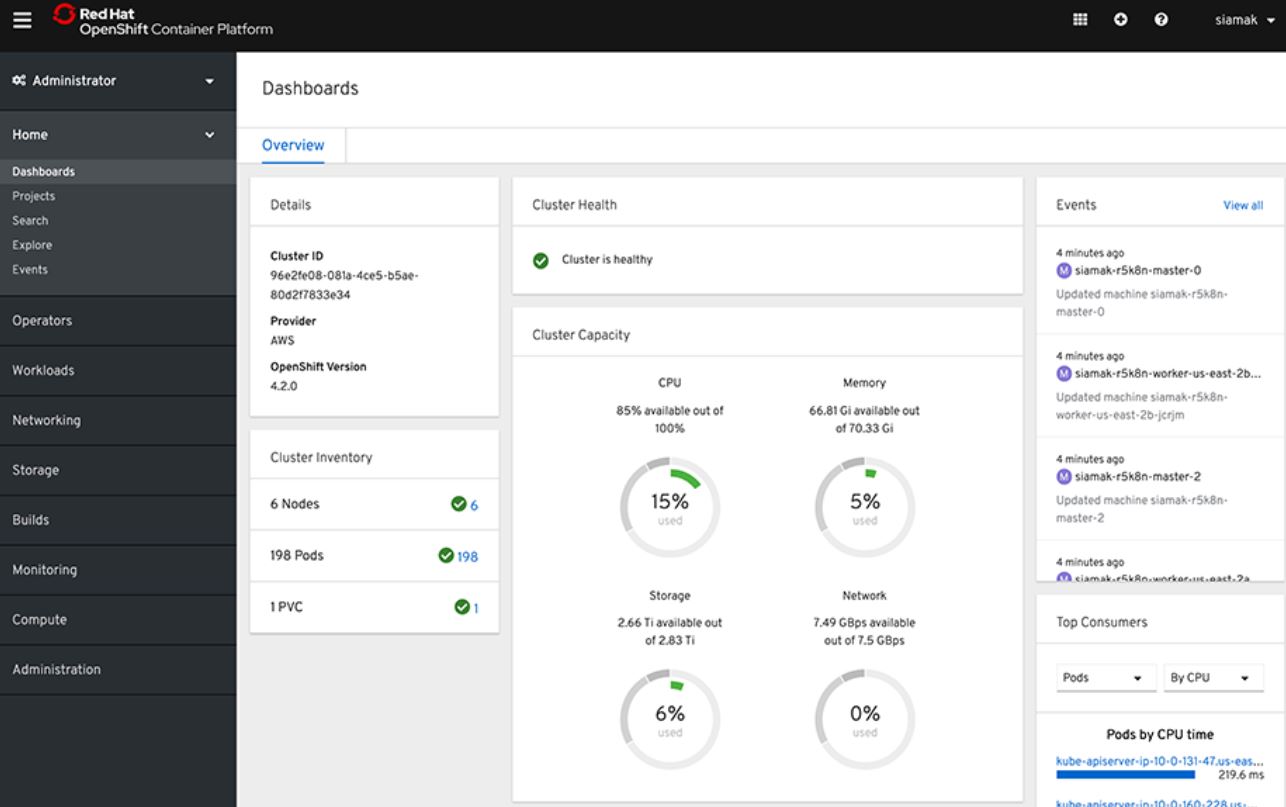OpenShift
About OpenShift
OpenShift Pricing
<li>Online: Free <li>Bronze: Free <li>Silver: $20.00/pm
Starting price:
$20.00 per month
Free trial:
Available
Free version:
Available

Most Helpful Reviews for OpenShift
1 - 5 of 25 Reviews
Praveen Kumar
Verified reviewer
Information Services, 201-500 employees
Used daily for more than 2 years
OVERALL RATING:
5
EASE OF USE
2
VALUE FOR MONEY
5
CUSTOMER SUPPORT
3
FUNCTIONALITY
4
Reviewed August 2021
Openshift: Best tool and software to manage the containers.
We are very happy with the Openshift and features that they offer to the container application deployment and security.
PROSIt's very easy to manage the container applications and issues related to them like container image scanning and the securities related to them before the production deployment.
CONSNot much resource is available in the market who are expert in the container application security in market.
Reason for choosing OpenShift
Openshift is very powerful and effective product from Red Hat. Red Hat created the c groups and namespace, they are expert in the containerised application software and they offered an incredible support when it comes to OpenShift and container security.
Reasons for switching to OpenShift
Apache Mesos was not very powerful in managing the up-growing of number of containers in the organisation.
Anonymous
10,000+ employees
Used daily for more than 2 years
OVERALL RATING:
5
EASE OF USE
5
VALUE FOR MONEY
5
CUSTOMER SUPPORT
4
FUNCTIONALITY
4
Reviewed December 2020
Perfect Container Orchestrator
It solved our use case of transitioning from monolith to microservices.
PROSIf you have microservices use case and have following questions like How to scale my services? How to monitor my services? How manage deployment? How to make services resilient to failures? Answer to all the above questions is Openshift. As it eases the pain of development and there is solution available to a known services deployment issue already. Integration of our existing services was smoothly done.
CONSWe didn't face any major issue while implementing or changing our deployment strategy for microservices. However as a developer I think there are many parts that one needs to understand to get going. But I don't think that as an issue. All tools have some learning curve and Openshift is no different.
Reason for choosing OpenShift
It is backed by Redhat. We already have Redhat Products everywhere in our organization so it was a natural choice. Not just that even comparing with similar tools it provides more and same features.
Reasons for switching to OpenShift
It takes quite a bit of effort to setup spring cloud and we wanted to come out of that zone. Openshift by default provides all the features and more we were using with Spring cloud.
Anonymous
10,000+ employees
Used weekly for more than 2 years
OVERALL RATING:
4
EASE OF USE
3
FUNCTIONALITY
4
Reviewed March 2024
Container Orchestration Made Easy
- Openshift UI to easily deploy, scale and destroy pods. - Has Kubernetes features - Support for public and private cloud deployments
CONSSometimes deployments/pods get stuck and are not deleted even after multiple retries.
Anonymous
2-10 employees
Used daily for less than 2 years
OVERALL RATING:
1
EASE OF USE
1
VALUE FOR MONEY
3
CUSTOMER SUPPORT
1
FUNCTIONALITY
1
Reviewed November 2021
Openshift - had to leave for Linode due to the forced and abrupt move from Openshift v2 to v3
It was an excellent product, Red Hat's management and treatment of users is the problem.
PROSOpenshift v2 was an excellent product that I couldn't fault at all, in fact I really really liked it. The problem came when Red Hat wanted everyone to move from v2 to v3 and gave very short notice and a very short timeline. Version 3 was completely different, based on containers.
CONSAs stated above, the real problem with Openshift is the way Red Hat forced everyone to move from v2 to v3 in a ridiculously short time. Documentation for migration was useless, I tried to migrate using it - it all failed. I could not trust Red Hat again after that experience, so I moved to Linode and have never looked back.
Marco
Verified reviewer
1,001-5,000 employees
Used daily for less than 2 years
OVERALL RATING:
5
EASE OF USE
5
VALUE FOR MONEY
5
CUSTOMER SUPPORT
3
FUNCTIONALITY
5
Reviewed July 2018
Starting a new era in software architecture
Easy to use, full of useful feature. It make easy and valuable migration to innovative achitecture based on containerized approach. You can use a community edition (Openshift Origin) or chose the RED HAT edition. Based on Kubernetes. Fully integrated with many other useful tool for monitoring and manager the full software cycle, until the deploy.
CONSDocumentation is still poor. Not so fast in receive support from community. Security aspect need to be better debeate.





